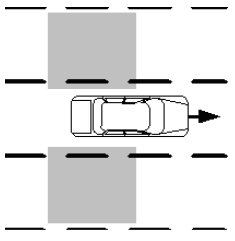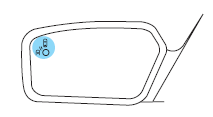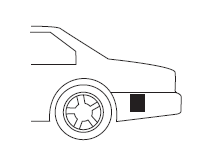Blind spot information system (BLIS ) With crosstraffic alert (CTA) (If equipped)

The BLIS is a convenience feature that aids the driver in assessing whether a vehicle is within an area on either side of the vehicle extending rearward from the outside mirrors to approximately 10 feet (3 meters) beyond the bumper. This area is referred to as the blind zone.
The BLIS will alert the driver to the presence of motorized vehicles in these areas while driving on roads and freeways.
The system is not designed to prevent contact with other vehicles or objects. The system is designed to provide a warning to assist the driver in detecting vehicles in the blind zones. The system will not detect infrastructure, pedestrians, or cyclists.

WARNING: To help avoid injuries, NEVER use the BLIS as a replacement for using the side and rear view mirrors and looking over your shoulder before changing lanes. BLIS is not a replacement for careful driving and only an assist.
The BLIS and CTA has a yellow indicator (also referred to as the alert) located in the left and right exterior mirrors. When the vehicle is started, the BLIS automatically illuminates both indicators for several seconds indicating the system is operating. The first time you place the transmission in D (Drive) after starting the engine and drive forward at a speed greater than 3 mph (5 km/h) the BLIS system becomes active. Afterwards, the BLIS remains active for all speeds including zero mph. BLIS is also active if the transmission is placed in N (Neutral). If the transmission is shifted out of D (Drive) or N (Neutral) the system will enter the CTA mode (see CTA operation below). Once shifted back into D (Drive) the BLIS mode will activate once driven above 3 mph (5 km/h).

The BLIS will trigger the alert for vehicles that enter your blind zone from the rear or merge into the blind zone from the side. Vehicles that you pass, or a vehicle that enters the blind zone from the front, will trigger the alert only after the vehicle is present in the blind zone for three seconds. Note: For vehicles that pass through the blind zone quickly, typically less than two seconds, the BLIS will not illuminate the alert.
The BLIS consists of two radar sensors each located rearward of the rear wheels hidden behind the bumper fascia. Do not place any type of bumper sticker in this area.
Note: The BLIS typically will not detect parked vehicles, humans, animals, or infrastructure (fences, guard rails, trees, etc.). The BLIS does not function when the transmission is in R (Reverse) or P (Park).
The BLIS does not provide any additional warning when your turn signal is activated.

BLIS detection limitations: Due to the nature of radar technology, there may be certain instances where vehicles entering and exiting the blind spot zones may not be detected. Below is a list of circumstances that may cause non-detection:
Х Debris build-up on the rear quarter panel fascias
Х Certain maneuvering of vehicles entering and exiting the blind zone
Х Vehicles passing through the blind zone at very fast rates
Х Severe weather conditions
Х When several vehicles forming a convoy pass through the blind zone.
See also:
Removing the jumper cables
Remove the jumper cables in the reverse order that they were
connected.
Note: In the illustration, the vehicle on the bottom is used to designate
the assisting (boosting) battery.
1. Remove ...
Power rear sunshade
Your vehicle is equipped with a power
rear sunshade that covers the rear
window of your vehicle. The control is
located in the center console access
bin next to the power point.
Press the c ...
Protecting your investment
Maintenance is an investment that will pay dividends in the form of
improved reliability, durability and resale value. To ensure the proper
performance of your vehicle and its emission control sys ...
